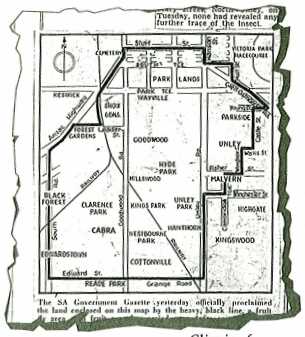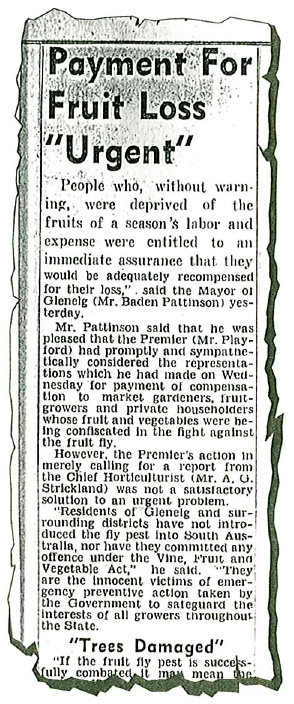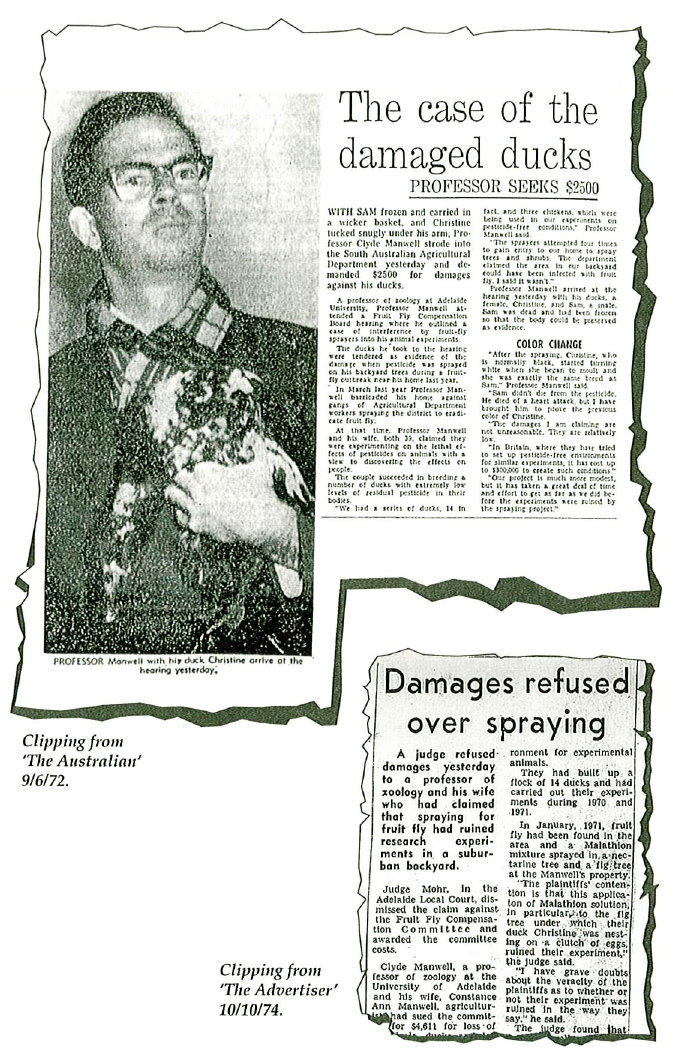Legislation
The Vine, Fruit and Vegetable Protection Act, of 1885, was designed ‘to prevent the introduction and to provide for the destruction of certain insects, and the eradication of diseases which injuriously affect vegetation’. There have been many changes to the Act since 1885 which have reflected the State’s approach to the prevention of entry of fruit flies into South Australia and to the eradication of outbreaks.
Under the Vine, Fruit and Vegetable Protection Act 1885–1936, the Governor proclaimed each outbreak and published Regulations for the prevention of the spread of infestations. Each Proclamation was printed in the South Australian Government Gazette and was effective for twelve months.
Many Proclamations have named particular species of fruit flies as insects under the Act, while Regulations, issued since 1931, have controlled the introduction of fresh fruit and vegetables into South Australia as well as detailing eradication and fruit compensation procedures.

Regulations for fruit entering South Australia
In 1931 a Regulation under the Vine, Fruit and Vegetable Protection Act permitted fruit that was grown in other states to be transported across South Australia. Introduction of trees, plants and fruit were regulated under these provisions in 1932. One section of the schedule was most important; no fruit could be introduced into South Australia from any State in which Med fly was known to exist, unless accompanied by a certification signed by an authorised inspector. The certificate declared that the orchard in which the fruit was grown and all the land within fifty miles had been free from Medfly for at least the previous three years. During 1935, fruit from the River Murray districts of New South Wales and Victoria was allowed to enter South Australia by road vehicle whereas previously, all fruit had to enter by rail.
Fruit and Plant Protection Act of 1968
In 1968, the Vine, Fruit and Vegetable Protection Act and its amendments were repealed and assent was given to the Fruit and Plant Protection Act. This new Act attempted to achieve greater flexibility of operation than the previous act.
Host fruit (other than grapes) from any State where Qfly or Medfly are known to exist must be accompanied by a certificate of area freedom or specific commodity treatment. An area free of fruit flies was defined as the property on which the fruit was grown and packed together with the area within a 30 km radius of that property, being free of fruit flies for at least one year prior to the harvesting of the fruit.
Late in 1986, grape berries (previously prohibited entry) were permitted entry as long as they were grown and packed in an area free of fruit flies as defined in the Regulations. Also, specific insects were named as insects within the meaning of the Act. Qfly, Medfly and Bactrocera jarvisi (Jarvis’ fruit fly) were declared again and B. aquilonis was added to the list. B. jarvisi and B. aquilonis were specifically declared because they were occasionally found in commercial consignments of fruit from the Darwin area.
A new Fruit and Plant Protection Act of 1992
This Act improved the powers to prevent the introduction of defined hosts, improved the power to destroy this produce, substantially increased penalties, introduced expiation fees, provided for accredited production areas and provided for the declaration of quarantine stations.
Compensation
One of the treatments used in eradicating outbreaks of fruit fly from 1947 to 1975 was the intensive removal of host fruit and plants from the central area of the outbreak. The Fruit Fly Act of 1947 legitimised destruction and control of certain insects affecting fruit and vegetables and allowed growers to be compensated for loss by the State. The Act was amended in each outbreak year. The first schedule of the Proclamation stated the suburbs involved and accurately defined the boundaries. The second schedule was a form of authority for the removal of fruit from properties. A map of the outbreak area was published in the daily newspapers. Compensation for fruit destroyed was an important part of public acceptance of fruit fly operations intruding into the lives of citizens.
To promote goodwill, receipts were issued to householders for fruit and plants removed and they were later invited to submit claims for compensation. A Fruit Fly Compensation Committee was appointed under the Fruit Fly Act to adjudicate on claims, and an enabling Act (Fruit Fly Compensation Act) was passed each year that an outbreak occurred. After 1960, the area that was stripped of fruit and plants was progressively reduced from the area within one mile radius to one half mile radius, resulting in a drop in the costs paid in compensation. After 1975–76, only trees with infested fruit near the outbreak centre, and nearby trees with fruit, had ripe fruit removed.

The total compensation paid by the government through the Fruit Fly Compensation Committee between 1946 and 1976 for fruit removed from householder’s trees was $1,087,848.

